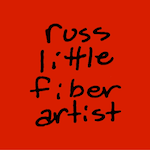Layers upon Layers: Day 5 and beyond
I've been home from Ohio for a week. I drove home last Saturday and I'm please to say that all went well with the trip. I've been having trouble with my eyes for the last year (since the surgery) and I was really concerned about managing a 6.5 hour car trip without any double vision or ocular migraines, both of which are triggered by stress, fatigue, and eye strain. It was smooth sailing. So anyway, the last day at the Barn was good. I did some tests with fabric paint using materials and methods that I hadn't used before. I've always screened, painted, or printed with fabric paint and other acrylics, but rollering/rubbing (which I've done successfully with dye) was new to me. I'm happy with the results and I think I've got some ideas for some new layering.
The first shot below shows a transparent paint (mixed from ProFab Extender and pigment). All 4 images were created from a simple collograph:
- Upper left: rollering paint with a dense foam roller over fabric placed on top of the plate
- Lower left: rollering paint onto the printing plate then hand rubbing a print with dry fabric
- Lower right: same as #2 but with fabric lightly dampened with a spray bottle
- Upper right: a sort of modified monotype print created by rollering paint onto plastic sheeting then stacking the printing plate, fabric and plastic sheeting (paint side down) and rubbing.
This second image is a set of similar prints made with opaque black ProFab paint.
- Upper left: rollering paint with a dense foam roller over fabric placed on top of the plate
- Upper right: rollering paint onto the printing plate then hand rubbing a print with slightly damp fabric
- Lower left: a print taken by rollering over some yarn couched to a piece of fabric (instead of the collograph.
- Lower right: the collograph plate after all was said and done.
Lessons
- There's layering potential here.
- The couched yarn is the most exciting image.
- The roller imparts a certain amount of texture on its own.
- A small roller creates marks that contribute to the overall story/feeling of the print. perhaps more than a wider roller would.
- I'm going to start mixing all of my paint from primary pigments instead of primary paints. There's more control and it makes more sense than holding an inventory of aging paint in colors that I might use infrequently.
Bottom line for the week
Carol's new class was great and I recommend it for anyone who is interested in exploring the concepts of layering line, shape, technique, texture, color, and meaning; all while playing with sequence of those things. I've taken both of Carol's color mixing classes and definitely benefited from that experience in this class because I had no anxiety about handing the dye primaries. That said, there were quite a few people in the class who did not have that experience and got along just fine with the hand outs and some direction from Carol. Basically it's a good class for any surface designer looking for a time and space to try new things and have their familiar ways of working shaken up a bit.


